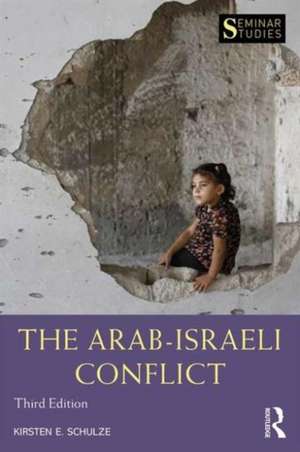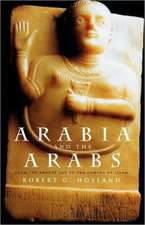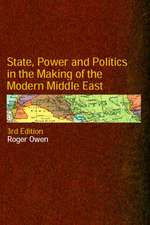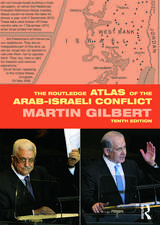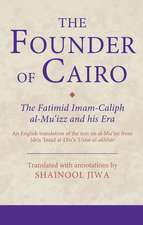The Arab-Israeli Conflict: Seminar Studies
Autor Kirsten E. Schulzeen Limba Engleză Paperback – 7 noi 2016
This third edition has been revised throughout to bring the text up to date
with recent events, including:
• a completely new chapter on the Gaza Wars from 2006 to 2014
• new material on the Arab Spring and its implications for Israel
• an updated discussion of the ongoing negotiations for peace.
Containing a diverse collection of primary source documents, a chronology of key dates, a glossary, a guide to further reading and a Who’s Who summarizing the careers and contributions of the main figures, this book is essential to understanding the background to and worldwide significance of the continuing violence between Israel and Palestine and is valuable reading for all students of the Arab–Israeli conflict.
| Toate formatele și edițiile | Preț | Express |
|---|---|---|
| Paperback (1) | 308.03 lei 3-5 săpt. | +20.19 lei 7-11 zile |
| Taylor & Francis – 7 noi 2016 | 308.03 lei 3-5 săpt. | +20.19 lei 7-11 zile |
| Hardback (1) | 708.55 lei 6-8 săpt. | |
| Taylor & Francis – 7 noi 2016 | 708.55 lei 6-8 săpt. |
Din seria Seminar Studies
-
 Preț: 305.61 lei
Preț: 305.61 lei -
 Preț: 394.47 lei
Preț: 394.47 lei -
 Preț: 193.64 lei
Preț: 193.64 lei -
 Preț: 322.38 lei
Preț: 322.38 lei -
 Preț: 211.76 lei
Preț: 211.76 lei -
 Preț: 308.30 lei
Preț: 308.30 lei -
 Preț: 307.26 lei
Preț: 307.26 lei -
 Preț: 307.80 lei
Preț: 307.80 lei -
 Preț: 314.14 lei
Preț: 314.14 lei -
 Preț: 309.39 lei
Preț: 309.39 lei -
 Preț: 309.39 lei
Preț: 309.39 lei -
 Preț: 330.52 lei
Preț: 330.52 lei -
 Preț: 305.63 lei
Preț: 305.63 lei -
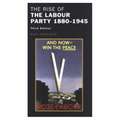 Preț: 314.50 lei
Preț: 314.50 lei -
 Preț: 316.72 lei
Preț: 316.72 lei -
 Preț: 307.65 lei
Preț: 307.65 lei -
 Preț: 308.52 lei
Preț: 308.52 lei -
 Preț: 307.27 lei
Preț: 307.27 lei -
 Preț: 299.85 lei
Preț: 299.85 lei -
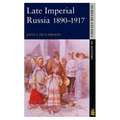 Preț: 314.14 lei
Preț: 314.14 lei -
 Preț: 306.94 lei
Preț: 306.94 lei -
 Preț: 314.42 lei
Preț: 314.42 lei -
 Preț: 402.80 lei
Preț: 402.80 lei -
 Preț: 305.90 lei
Preț: 305.90 lei -
 Preț: 346.51 lei
Preț: 346.51 lei -
 Preț: 310.45 lei
Preț: 310.45 lei -
 Preț: 306.00 lei
Preț: 306.00 lei -
 Preț: 306.39 lei
Preț: 306.39 lei -
 Preț: 306.39 lei
Preț: 306.39 lei -
 Preț: 349.57 lei
Preț: 349.57 lei -
 Preț: 306.06 lei
Preț: 306.06 lei -
 Preț: 304.42 lei
Preț: 304.42 lei -
 Preț: 314.03 lei
Preț: 314.03 lei -
 Preț: 332.21 lei
Preț: 332.21 lei -
 Preț: 306.29 lei
Preț: 306.29 lei -
 Preț: 308.52 lei
Preț: 308.52 lei -
 Preț: 204.23 lei
Preț: 204.23 lei -
 Preț: 307.93 lei
Preț: 307.93 lei -
 Preț: 306.29 lei
Preț: 306.29 lei -
 Preț: 427.54 lei
Preț: 427.54 lei -
 Preț: 316.55 lei
Preț: 316.55 lei -
 Preț: 330.10 lei
Preț: 330.10 lei -
 Preț: 266.29 lei
Preț: 266.29 lei -
 Preț: 305.47 lei
Preț: 305.47 lei -
 Preț: 348.97 lei
Preț: 348.97 lei -
 Preț: 308.91 lei
Preț: 308.91 lei -
 Preț: 308.03 lei
Preț: 308.03 lei -
 Preț: 307.93 lei
Preț: 307.93 lei -
 Preț: 305.97 lei
Preț: 305.97 lei -
 Preț: 305.90 lei
Preț: 305.90 lei
Preț: 308.03 lei
Nou
Puncte Express: 462
Preț estimativ în valută:
58.94€ • 61.75$ • 48.85£
58.94€ • 61.75$ • 48.85£
Carte disponibilă
Livrare economică 18 martie-01 aprilie
Livrare express 04-08 martie pentru 30.18 lei
Preluare comenzi: 021 569.72.76
Specificații
ISBN-13: 9781138933354
ISBN-10: 113893335X
Pagini: 226
Ilustrații: 10
Dimensiuni: 156 x 234 x 18 mm
Greutate: 0.34 kg
Ediția:Revised
Editura: Taylor & Francis
Colecția Routledge
Seria Seminar Studies
Locul publicării:Oxford, United Kingdom
ISBN-10: 113893335X
Pagini: 226
Ilustrații: 10
Dimensiuni: 156 x 234 x 18 mm
Greutate: 0.34 kg
Ediția:Revised
Editura: Taylor & Francis
Colecția Routledge
Seria Seminar Studies
Locul publicării:Oxford, United Kingdom
Public țintă
UndergraduateCuprins
Acknowledgements
List of figures
List of maps
Chronology
Who’s who
Maps
PART ONE BACKGROUND
1 THE ORIGINS OF THE ARAB–ISRAELI CONFLICT
Zionism and Arab Nationalism
The Impact of the First World War
British Policy and the Palestine Mandate
The Inter-war Period
The Impact of the Second World War
Partition
PART TWO WARS AND PEACE
2 THE 1948 WAR
The First Arab–Israeli War
The Palestinian Exodus
Peace Negotiations
3 THE 1956 SUEZ–SINAI CAMPAIGN
The 1952 Egyptian Coup
Israeli–Egyptian Tensions
The Israeli Foreign and Defence Policy Debate
British–French–Israeli Collaboration
The Results of the War
4 THE 1967 JUNE WAR
The Creation of the Palestine Liberation Organization
On the Brink of War
The Pre-emptive Strike
The Aftermath of the War
5 THE 1973 OCTOBER WAR
The War of Attrition
The Palestinian Revival and Black September
Syro–Egyptian Plans for War
The ‘Surprise’ Attack
Consequences of the War
6 THE EGYPTIAN–ISRAELI PEACE PROCESS
Disengagement
The 1977 Likud Victory
The Camp David Accords
Implications of Peace
7 THE 1982 LEBANON WAR
The Lebanese Civil War
Limited Israeli Intervention
Operation Peace for Galilee
The Failures of Operation Peace for Galilee
The 1983 May 17th Agreement
Repercussions of the Invasion
8 THE INTIFADA
The PLO after 1982
The Intifada Israeli Reaction
The Creation of Hamas
PART THREE THE MIDDLE EAST PEACE PROCESS
9 FROM MADRID TO THE SECOND INTIFADA:
ISRAELI–PALESTINIAN NEGOTIATIONS
The Madrid Conference and Framework for Peace
The Oslo Process, 1992–99
Palestinian Institutions and Society, 1996–99
The 2000 Camp David Summit
The Second Intifada Israel’s Response
Peace Initiatives, 2000–05
Assessing the Israeli-Palestinian Negotiations
10 ISRAEL, JORDAN, SYRIA AND LEBANON, 1994–2015
Peace with Jordan
Negotiations with Syria, 1994–95
Lebanon First, 1996–99
Israeli–Syrian Negotiations, 1999–2000
Assessing the Syrian-Israeli Negotiations, 1991-2005
The 2006 Lebanon War
The Syrian Jihad
11 Gaza Wars 2006-2014
The 2005 Unilateral Withdrawal from Gaza
The 2006 Ascendance of Hamas
GazaWars: Operation Summer Rains and Autumn Clouds, June-November 2006
The Battle of Gaza and the Blockade of Gaza
Gaza Wars: Operation Cast Lead, December 2008-January 2009
Gaza Wars: Operation Pillar of Defence, November 2012
Gaza Wars: Operation Protective Edge, July 2014
Making Sense of the Gaza Wars
PART FOUR ASSESSMENT
12
Understanding the Arab-Israeli Conflict: Patterns, Dynamics, Evolution and Conflict Resolution
PART FIVE DOCUMENTS
1 From The Jewish State2 From ;The Iron Wall’
3 From theHussein–McMahon Correspondence
4 The Balfour Declaration: 2 November 1917
5 From the Sykes–Picot Agreement
6 From the Recommendations of the Peel Commission July 1937
7 From the MacDonald White Paper: 17 May 1939
8 Plan D: 10 March 1948
From the Declaration of the Establishment of the State of Israel: 14 May 1948
10 From the Cabinet Discussions on the Czech Arms Deal: 4 October 1955
11 The Sevres Protocol: 24 October 1956
12 From the National Covenant of the Palestine Liberation Organization
13 UNSC Resolution 242: 22 November 1967
14 From the Khartoum Summit: 1 September 1967
15 UNSC Resolution 338: 22 October 1973
16 From Sadat’s Announcement to the Egyptian National Assembly:
9 November 1977
17 From the Camp David Accords: 17 September 1978
18 From the Reagan Fresh Start Initiative: 1 September 1982
19 From the Fez Peace Plan: 9 September 1982
20 From the Israel–Lebanon Agreement: 17 May 1983
21 The Amman Agreement, or Hussein–Arafat Accord: 11 February 1985
22 Jordan Relinquishes its Claim to the West Bank: 31 July 1988
23 From the Hamas Charter: 18 August 1988
24 Palestinian Declaration of Independence: 15 November 1988
25 Madrid Conference Letter of Invitation: 18 October 1991
26 From the Declaration of Principles: 9 September 1993
27 Israeli–Jordanian Peace Agreement: 26 October 1994
28 A Performance-Based Roadmap to a Permanent Two-State
Solution to the Israeli–Palestinian Conflict
29 From the 2014 Gaza Ceasefire Agreement
Glossary
FURTHER READING
REFERENCES
INDEX
List of figures
List of maps
Chronology
Who’s who
Maps
PART ONE BACKGROUND
1 THE ORIGINS OF THE ARAB–ISRAELI CONFLICT
Zionism and Arab Nationalism
The Impact of the First World War
British Policy and the Palestine Mandate
The Inter-war Period
The Impact of the Second World War
Partition
PART TWO WARS AND PEACE
2 THE 1948 WAR
The First Arab–Israeli War
The Palestinian Exodus
Peace Negotiations
3 THE 1956 SUEZ–SINAI CAMPAIGN
The 1952 Egyptian Coup
Israeli–Egyptian Tensions
The Israeli Foreign and Defence Policy Debate
British–French–Israeli Collaboration
The Results of the War
4 THE 1967 JUNE WAR
The Creation of the Palestine Liberation Organization
On the Brink of War
The Pre-emptive Strike
The Aftermath of the War
5 THE 1973 OCTOBER WAR
The War of Attrition
The Palestinian Revival and Black September
Syro–Egyptian Plans for War
The ‘Surprise’ Attack
Consequences of the War
6 THE EGYPTIAN–ISRAELI PEACE PROCESS
Disengagement
The 1977 Likud Victory
The Camp David Accords
Implications of Peace
7 THE 1982 LEBANON WAR
The Lebanese Civil War
Limited Israeli Intervention
Operation Peace for Galilee
The Failures of Operation Peace for Galilee
The 1983 May 17th Agreement
Repercussions of the Invasion
8 THE INTIFADA
The PLO after 1982
The Intifada Israeli Reaction
The Creation of Hamas
PART THREE THE MIDDLE EAST PEACE PROCESS
9 FROM MADRID TO THE SECOND INTIFADA:
ISRAELI–PALESTINIAN NEGOTIATIONS
The Madrid Conference and Framework for Peace
The Oslo Process, 1992–99
Palestinian Institutions and Society, 1996–99
The 2000 Camp David Summit
The Second Intifada Israel’s Response
Peace Initiatives, 2000–05
Assessing the Israeli-Palestinian Negotiations
10 ISRAEL, JORDAN, SYRIA AND LEBANON, 1994–2015
Peace with Jordan
Negotiations with Syria, 1994–95
Lebanon First, 1996–99
Israeli–Syrian Negotiations, 1999–2000
Assessing the Syrian-Israeli Negotiations, 1991-2005
The 2006 Lebanon War
The Syrian Jihad
11 Gaza Wars 2006-2014
The 2005 Unilateral Withdrawal from Gaza
The 2006 Ascendance of Hamas
GazaWars: Operation Summer Rains and Autumn Clouds, June-November 2006
The Battle of Gaza and the Blockade of Gaza
Gaza Wars: Operation Cast Lead, December 2008-January 2009
Gaza Wars: Operation Pillar of Defence, November 2012
Gaza Wars: Operation Protective Edge, July 2014
Making Sense of the Gaza Wars
PART FOUR ASSESSMENT
12
Understanding the Arab-Israeli Conflict: Patterns, Dynamics, Evolution and Conflict Resolution
PART FIVE DOCUMENTS
1 From The Jewish State2 From ;The Iron Wall’
3 From theHussein–McMahon Correspondence
4 The Balfour Declaration: 2 November 1917
5 From the Sykes–Picot Agreement
6 From the Recommendations of the Peel Commission July 1937
7 From the MacDonald White Paper: 17 May 1939
8 Plan D: 10 March 1948
From the Declaration of the Establishment of the State of Israel: 14 May 1948
10 From the Cabinet Discussions on the Czech Arms Deal: 4 October 1955
11 The Sevres Protocol: 24 October 1956
12 From the National Covenant of the Palestine Liberation Organization
13 UNSC Resolution 242: 22 November 1967
14 From the Khartoum Summit: 1 September 1967
15 UNSC Resolution 338: 22 October 1973
16 From Sadat’s Announcement to the Egyptian National Assembly:
9 November 1977
17 From the Camp David Accords: 17 September 1978
18 From the Reagan Fresh Start Initiative: 1 September 1982
19 From the Fez Peace Plan: 9 September 1982
20 From the Israel–Lebanon Agreement: 17 May 1983
21 The Amman Agreement, or Hussein–Arafat Accord: 11 February 1985
22 Jordan Relinquishes its Claim to the West Bank: 31 July 1988
23 From the Hamas Charter: 18 August 1988
24 Palestinian Declaration of Independence: 15 November 1988
25 Madrid Conference Letter of Invitation: 18 October 1991
26 From the Declaration of Principles: 9 September 1993
27 Israeli–Jordanian Peace Agreement: 26 October 1994
28 A Performance-Based Roadmap to a Permanent Two-State
Solution to the Israeli–Palestinian Conflict
29 From the 2014 Gaza Ceasefire Agreement
Glossary
FURTHER READING
REFERENCES
INDEX
Notă biografică
Kirsten E. Schulze is Associate Professor in International History at the London School of Economics. Her recent publications include The International History of the Twentieth Century and Beyond (2014, 3rd edition, co-authored with Antony Best, Jussi Hanhimäki and Joseph A. Maiolo) and The Jews of Lebanon: Between Coexistence and Conflict (2008, 2nd edition), as well as articles on Israeli–Lebanese relations in the 1950s, Israel’s 1982 invasion of Lebanon and the al-Aqsa Intifada.
Recenzii
"Kirsten Schulze has produced a comprehensive and concise account that is highly recommended. The Arab-Israeli Conflict provides a sweeping overview from the origins of Zionism and Arab nationalism to Israel’s 2014 invasion of Gaza and the stalled peace process. Written in an engaging and accessible style with maps, key documents, and a glossary of terms, it is an ideal text for introductory and advanced undergraduate courses."
Osamah Khalil, Syracuse University, USA
"Complete with appropriately selected documents, maps, a chronology and a handy who’s who guide, Kirsten Schulze has delivered a comprehensive yet precise, balanced and digestible guide to the history of the Arab-Israeli Conflict from the rise of Zionism to the rise and fall of the peace process as well as more recent conflagrations. Essential reading for students of history, politics, Middle Eastern Studies and conflict resolution."
Simon Waldman, King’s College London, UK
Osamah Khalil, Syracuse University, USA
"Complete with appropriately selected documents, maps, a chronology and a handy who’s who guide, Kirsten Schulze has delivered a comprehensive yet precise, balanced and digestible guide to the history of the Arab-Israeli Conflict from the rise of Zionism to the rise and fall of the peace process as well as more recent conflagrations. Essential reading for students of history, politics, Middle Eastern Studies and conflict resolution."
Simon Waldman, King’s College London, UK
Descriere
In this concise yet comprehensive survey, Kirsten E. Schulze analyzes the Arab-Israeli conflict, exploring the particular dynamics of this conflict and the numerous attempts at its resolution. This third edition has been revised throughout to bring the text up to date with recent events, including:
- a completely new chapter on the Gaza Wars from 2006 to 2014
- new material on the Arab Spring and its implications for Israel
- an updated discussion of the ongoing negotiations for peace.
